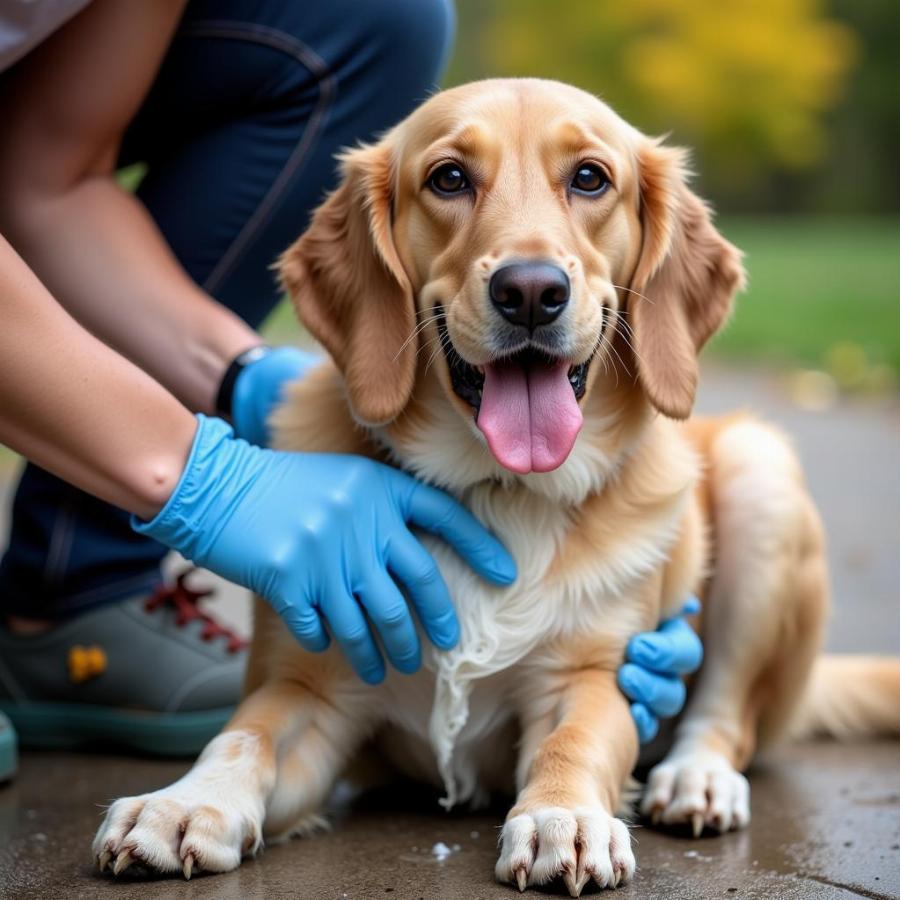Poison ivy is a common plant that can cause a painful, itchy rash in humans. But did you know that your furry friend can also be affected by this pesky plant? While dogs are less susceptible than humans to the irritating oils of poison ivy, it’s still important to be aware of the risks and how to protect your canine companion. Knowing what to look for and how to react can save your dog a lot of discomfort.
Identifying Poison Ivy and Its Effects on Dogs
Poison ivy (Toxicodendron radicans) is characterized by its three-leaf clusters. The saying “Leaves of three, let it be” is a helpful reminder. The leaves can vary in size and shape, and may be glossy or dull, but the three-leaf arrangement is consistent. The plant can grow as a vine, a shrub, or even climb trees. While dogs have thicker skin and fur than humans, which offers some protection, exposed areas like their belly, groin, and paws are still vulnerable.
So, what does poison ivy look like on a dog? The reaction manifests as a red, itchy rash, often with blisters. You might notice your dog excessively licking or chewing at the affected area, which can further irritate the skin and potentially lead to secondary infections. Unlike humans, dogs don’t usually develop widespread rashes from poison ivy, but localized reactions can still be quite uncomfortable.
What to Do If Your Dog Comes into Contact with Poison Ivy
If you suspect your dog has brushed up against poison ivy, the first step is to wash the affected area thoroughly. Use lukewarm water and a pet-safe soap, like oatmeal shampoo. Avoid using human shampoos, as they can dry out your dog’s skin and exacerbate the irritation. Wear gloves during the washing process to prevent transferring the urusiol oil, the irritant in poison ivy, to yourself.
 Washing a Dog After Poison Ivy Contact
Washing a Dog After Poison Ivy Contact
Preventing Future Encounters
The best way to deal with poison ivy is to prevent exposure altogether. Learn to identify poison ivy in your yard and surrounding areas. Consider removing the plants if possible, or create barriers to keep your dog away. When walking your dog, stay on designated paths and avoid letting them roam in areas with dense vegetation. Dog paw gloves can offer an extra layer of protection, particularly for dogs who love to explore.
When to Seek Veterinary Care
While mild cases of poison ivy on dogs can often be managed at home, it’s important to seek veterinary care if your dog develops a severe reaction, the rash spreads, or there are signs of infection such as pus or increased swelling. Your veterinarian might prescribe medications like antihistamines or corticosteroids to reduce itching and inflammation.
Home Remedies for Mild Cases
For milder cases, you can try applying a cool compress to the affected area to soothe the itch. Dog poison ivy pictures can be a great resource to help identify what the rash looks like and how severe it is. You can also consult with your veterinarian about using over-the-counter topical creams or sprays specifically formulated for pets.
Other Poisonous Plants for Dogs
Poison ivy isn’t the only plant that poses a threat to dogs. Many common garden plants and weeds dangerous to dogs can be toxic if ingested. It’s crucial to be aware of these potential hazards and take precautions to keep your dog safe. For example, the popular pothos plant poisonous to dogs should be kept well out of reach of your furry friend.
Conclusion
Poison ivy on a dog can be an uncomfortable experience, but with quick action and proper care, you can help your furry companion recover quickly. Learning to identify poison ivy and taking preventive measures are key to protecting your dog from this irritating plant. Remember to consult with your veterinarian if you have any concerns or if your dog develops a severe reaction.
FAQs: Poison Ivy on Dogs
- Can poison ivy spread from my dog to me? No, the rash itself is not contagious. However, the urushiol oil can be transferred from your dog’s fur to your skin. Washing your dog thoroughly and washing your hands after handling them are essential.
- How long does it take for poison ivy to show up on a dog? Similar to humans, the reaction can appear anywhere from a few hours to a few days after exposure.
- Are some dog breeds more susceptible to poison ivy? No, any dog can develop a reaction to poison ivy, though dogs with shorter coats or thinner skin might be more vulnerable.
- Can I use human anti-itch cream on my dog? It’s best to avoid using human products on your dog. Consult your veterinarian for safe and effective treatment options.
- What are the long-term effects of poison ivy on dogs? Generally, poison ivy doesn’t cause long-term problems for dogs. With proper care, the rash should resolve within a couple of weeks.
- Can my dog get poison ivy from another dog? No, the rash isn’t contagious between dogs. However, they can both be exposed to the same source of urushiol oil.
- What should I do if my dog eats poison ivy? Contact your veterinarian immediately. Ingesting poison ivy can cause gastrointestinal upset.
Related Topics:
Interested in learning more about dog health and safety? Check out our other articles on toxic plants, first aid for dogs, and general dog care tips.
Beaut Dogs is your one-stop resource for all things dog-related, providing reliable, helpful, and in-depth information about the canine world. From breed characteristics and care guides to health tips and product recommendations, we’re dedicated to helping you provide the best possible care for your beloved companion. When you need assistance, please contact us via Email: [email protected] for detailed and accurate answers from Beaut Dogs. Beaut Dogs is here to help!